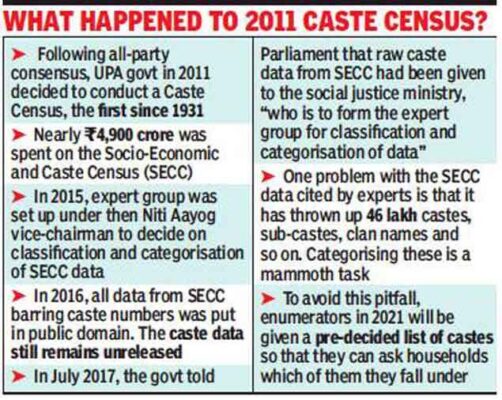OBC Count in Census
 Recently, the National Commission for Backward Classes (NCBC) has urged the Ministry of Social Justice and Empowerment to collect data on the population of Other Backward Classes (OBCs) in the country “as part of Census of India 2021 exercise”.
Recently, the National Commission for Backward Classes (NCBC) has urged the Ministry of Social Justice and Empowerment to collect data on the population of Other Backward Classes (OBCs) in the country “as part of Census of India 2021 exercise”.
- In January 2020, both the Odisha and the Maharashtra governments had adopted resolutions urging the government to determine the population of OBCs in the country.
- In February 2020, Bihar became the third state to pass a resolution in its assembly demanding that the 2021 Census exercise be based on caste.
- The Odisha government went a step further and ordered a survey into the socio-economic conditions of OBCs.
Need for OBC Count in Census
- The NCBC was granted constitutional status in 2018.
- The government has constituted a commission under chairmanship of former Chief Justice of Delhi High Court Justice G Rohini to sub-categorise OBCs.
- The Rohini Commission is facing difficulties due to unavailability of data on various communities classified under OBCs.
- The panel had written to Social Justice and Empowerment Minister and requested for appropriate Budget provision for a proposed all-India survey for an estimate of caste-wise population of OBCs.
- The parliamentary standing committee on welfare of OBCs has recommended that a headcount of OBCs be conducted in the upcoming census.
History of Caste Census in India
- A population census was first carried out by the British colonial state in 1872 which enumerated the populations of various castes, including Brahmins, Kshatriyas and Rajputs, across several provinces.
- The caste populations were specifically counted based on their traditional occupationsat the time.
- The 1901 census identified 1,646 castes but the number rose to 4,147 in the 1931 caste census.
Why caste never made it to the census?
- There have been concerns because the last time a comprehensive data on caste was collected in India was way back in 1931.
- The category of ‘Race, Caste or Tribe’ was replaced by the ‘Scheduled Tribe/ Scheduled Caste’ after India got independence.
- There is little documentation about the discussion or debate that had transpired between leaders of the time on what the census would include.
- The leaders attributed that this shift to the belief that “including caste data in census enumeration will perpetuate the caste system and deepen social divisions”.
- The recording of caste was abandoned after Indian Independence in 1947 in order to help smooth the growth of a secular state.
- The leaders had wanted to drop the question of caste as it was thought of as a British policy to divide and rule.
-
- The British wanted to understand and control India through their understanding of religion and caste.
- The issue of the caste census has always been a politically-charged one because of its implications on the percentage of reservation in education and jobs.
Census in post-Mandal era
- The First Backward Classes Commission constituted under Kaka Kalelkar in 1953 has prepared a list of 2,399 backward castes or communities for the entire country.
- The registrar general and census commissioner of India at the time also assisted the Commission in making population projections of 930 backward castes or communities.
- In 1979, with the appointment of the Mandal Commission that an estimate of ‘other backward classes’ would be attempted.
- It was made on the basis of the 1931 Census, on an assumption of uniform growth for all religious groups and communities in the next half a century.
- The Mandal Commission report resulted in the provision of a 49.5 per cent quota in government jobs and public universities which included a declaration for 27 per cent reservation for OBCs.
Next
previous
 Recently, the National Commission for Backward Classes (NCBC) has urged the Ministry of Social Justice and Empowerment to collect data on the population of Other Backward Classes (OBCs) in the country “as part of Census of India 2021 exercise”.
Recently, the National Commission for Backward Classes (NCBC) has urged the Ministry of Social Justice and Empowerment to collect data on the population of Other Backward Classes (OBCs) in the country “as part of Census of India 2021 exercise”.









 Latest News
Latest News
 General Studies
General Studies